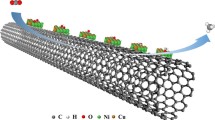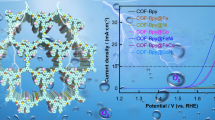Abstract
The rational design of highly active and stable atomically dispersed M-X4 (M = Fe, Co, Ni, etc., X = C, N) -based catalysts holds promises for wide application in almost all realms of catalysis. Despite great effort in the construction of specific M-X4 centers, the possible effect of non-coordinated heteroatoms on the catalytic activity of metal centers has been rarely explored. Herein, we develop a new type of M-X4 catalyst composed of Fe-N4 centers and non-coordinated B heteroatoms (FeNC+B) and find the key role of non-coordinated B adjacent to Fe-N4 centers in tailoring their electron density and final catalytic selectivity. The experimental and theoretical results demonstrated that non-coordinated boron atoms could decrease the electron density of Fe-N4 centers to a suitable level and thus boost the selective production of nitriles from amine oxidation by depressing the formation of imines due to the flattened energy barrier of the reversible conversion of imines back to amines. As a reusable heterocatalyst, the state-of-the-art FeNC+B catalyst provides a turn-over frequency (TOF) value of 21.6 molbenzonitrile·molFe−1·h−1 (100 °C), outpacing that of bench-marked nonnoble-metal-based homogeneous catalyst by a factor of 3.4.

Similar content being viewed by others
References
Wang, Y.; Mao, J.; Meng, X. G.; Yu, L.; Deng, D. H.; Bao, X. H. Catalysis with two-dimensional materials confining single atoms: Concept, design, and applications. Chem. Rev.2019, 119, 1806–1854.
Byon, H. R.; Suntivich, J.; Shao-Horn, Y. Graphene-based non-noble-metal catalysts for oxygen reduction reaction in acid. Chem. Mater.2011, 23, 3421–3428.
Jiao, L.; Wan, G.; Zhang, R.; Zhou, H.; Yu, S. H.; Jiang, H. L. From metal-organic frameworks to single-atom Fe implanted N-doped porous carbons: Efficient oxygen reduction in both alkaline and acidic media. Angew. Chem., Int. Ed.2018, 57, 8525–8529.
Wang, X. Q.; Chen, Z.; Zhao, X. Y.; Yao, T.; Chen, W. X.; You, R.; Zhao, C. M.; Wu, G.; Wang, J.; Huang, W. X. et al. Regulation of coordination number over single Co sites: Triggering the efficient electroreduction of CO2. Angew. Chem., Int. Ed.2018, 57, 1944–1948.
Li, X. G.; Bi, W. T.; Chen, M. L.; Sun, Y. X.; Ju, H. X.; Yan, W. S.; Zhu, J. F.; Wu, X. J.; Chu, W. S.; Wu, C. Z. et al. Exclusive Ni-N4 sites realize near-unity CO selectivity for electrochemical CO2 reduction. J. Am. Chem. Soc.2017, 139, 14889–14892.
Yang, Q. H.; Yang, C. C.; Lin, C. H.; Jiang, H. L. Metal-organic-framework-derived hollow N-doped porous carbon with ultrahigh concentrations of single Zn atoms for efficient carbon dioxide conversion. Angew. Chem., Int. Ed.2019, 58, 3511–3515.
Han, L. L.; Liu, X. J.; Chen, J. P.; Lin, R. Q.; Liu, H. X.; Lü, F.; Bak, S.; Liang, Z. X.; Zhao, S. Z.; Stavitski, E. et al. Atomically dispersed molybdenum catalysts for efficient ambient nitrogen fixation. Angew. Chem., Int. Ed.2019, 58, 2321–2325.
Chen, W. X.; Pei, J. J.; He, C. T.; Wan, J. W.; Ren, H. L.; Zhu, Y. Q.; Wang, Y.; Dong, J. C.; Tian, S. B.; Cheong, W. C. et al. Rational design of single molybdenum atoms anchored on N-doped carbon for effective hydrogen evolution reaction. Angew. Chem., Int. Ed.2017, 56, 16086–16090.
Qiu, H. J.; Ito, Y.; Cong, W. T.; Tan, Y. W.; Liu, P.; Hirata, A.; Fujita, T.; Tang, Z.; Chen, M. W. Nanoporous graphene with single-atom nickel dopants: An efficient and stable catalyst for electrochemical hydrogen production. Angew. Chem., Int. Ed.2015, 54, 14031–14035.
Fei, H. L.; Dong, J. C.; Feng, Y. X.; Allen, C. S.; Wan, C. Z.; Volosskiy, B.; Li, M. F.; Zhao, Z. P.; Wang, Y. L.; Sun, H. T. et al. General synthesis and definitive structural identification of MN4C4 single-atom catalysts with tunable electrocatalytic activities. Nat. Catal.2018, 1, 63–72.
Fei, H. L.; Dong, J. C.; Arellano-Jiménez, M. J.; Ye, G. L.; Dong Kim, N.; Samuel, E. L. G.; Peng, Z. W.; Zhu, Z.; Qin, F.; Bao, J. M. et al. Atomic cobalt on nitrogen-doped graphene for hydrogen generation. Nat. Commun.2015, 6, 8668.
Zhang, L. Z.; Jia, Y.; Gao, G. P.; Yan, X. C.; Chen, N.; Chen, J.; Soo, M. T.; Wood, B.; Yang, D. J.; Du, A. J. et al. Graphene defects trap atomic Ni species for hydrogen and oxygen evolution reactions. Chem2018, 4, 285–297.
Sun, T. T.; Zhao, S.; Chen, W. X.; Zhai, D.; Dong, J. C.; Wang, Y.; Zhang, S. L.; Han, A. J.; Gu, L.; Yu, R. et al. Single-atomic cobalt sites embedded in hierarchically ordered porous nitrogen-doped carbon as a superior bifunctional electrocatalyst. Proc. Natl. Acad. Sci. USA2018, 115, 12692–12697.
Guan, J. Q.; Duan, Z. Y.; Zhang, F. X.; Kelly, S. D.; Si, R.; Dupuis, M.; Huang, Q. G.; Chen, J. Q.; Tang, C. H.; Li, C. Water oxidation on a mononuclear manganese heterogeneous catalyst. Nat. Catal.2018, 1, 870–877.
Ji, S. F.; Chen, Y. J.; Zhang, Z. D.; Cheong, W. C.; Liu, Z. R.; Wang, D. S.; Li, Y. D. Single-atomic-site cobalt stabilized on nitrogen and phosphorus co-doped carbon for selective oxidation of primary alcohols. Nanoscale Horiz.2019, 4, 902–906.
Lv, L. B.; Yang, S. Z.; Ke, W. Y.; Wang, H. H.; Zhang, B.; Zhang, P. F.; Li, X. H.; Chisholm, M. F.; Chen, J. S. Mono-atomic Fe centers in nitrogen/carbon monolayers for liquid-phase selective oxidation reaction. ChemCatChem2018, 10, 3539–3545.
Su, H.; Gao, P.; Wang, M. Y.; Zhai, G. Y.; Zhang, J. J.; Zhao, T. J.; Su, J.; Antonietti, M.; Li, X. H.; Chen, J. S. Grouping effect of single Ni-N4 sites in Nitrogen-doped carbon boosts hydrogen transfer coupling of alcohols and amines. Angew. Chem., Int. Ed.2018, 57, 15194–15198.
Han, Y. H.; Wang, Z. Y.; Xu, R. R.; Zhang, W.; Chen, W. X.; Zheng, L. R.; Zhang, J.; Luo, J.; Wu, K. L.; Zhu, Y. Q. et al. Ordered porous nitrogen-doped carbon matrix with atomically dispersed cobalt sites as an efficient catalyst for dehydrogenation and transfer hydrogenation of N-heterocycles. Angew. Chem., Int. Ed.2018, 57, 11262–11266.
Wang, S. H.; Shang, L.; Li, L. L.; Yu, Y. J.; Chi, C. W.; Wang, K.; Zhang, J.; Shi, R.; Shen, H. Y.; Waterhouse, G. I. N. et al. Metal-organic-framework-derived mesoporous carbon nanospheres containing porphyrin-like metal centers for conformal phototherapy. Adv. Mater.2016, 28, 8379–8387.
Liu, Y. X.; Wang, H. H.; Zhao, T. J.; Zhang, B.; Su, H.; Xue, Z. H.; Li, X. H.; Chen, J. S. Schottky barrier induced coupled interface of electron-rich N-doped carbon and electron-deficient Cu: In-built Lewis acid-base pairs for highly efficient CO2 fixation. J. Am. Chem. Soc.2019, 141, 38–41.
Su, H.; Zhang, K. X.; Zhang, B.; Wang, H. H.; Yu, Q. Y.; Li, X. H.; Antonietti, M.; Chen, J. S. Activating cobalt nanoparticles via the Mott-Schottky effect in nitrogen-rich carbon shells for base-free aerobic oxidation of alcohols to esters. J. Am. Chem. Soc.2017, 139, 811–818.
Li, X. H.; Antonietti, M. Polycondensation of boron- and nitrogencodoped holey graphene monoliths from molecules: Carbocatalysts for selective oxidation. Angew. Chem., Int. Ed.2013, 52, 4572–4576.
Zhang, K. X.; Su, H.; Wang, H. H.; Zhang, J. J.; Zhao, S. Y.; Lei, W. W.; Wei, X.; Li, X. H.; Chen, J. S. Atomic-scale Mott-Schottky heterojunctions of boron nitride monolayer and graphene as metal-free photocatalysts for artificial photosynthesis. Adv. Sci.2018, 5, 1800062.
Berteotti, A.; Vacondio, F.; Lodola, A.; Bassi, M.; Silva, C.; Mor, M.; Cavalli, A. Predicting the reactivity of nitrile-carrying compounds with cysteine: A combined computational and experimental study. ACS Med. Chem. Lett.2014, 5, 501–505.
Burow, M.; Markert, J.; Gershenzon, J.; Wittstock, U. Comparative biochemical characterization of nitrile-forming proteins from plants and insects that alter myrosinase-catalysed hydrolysis of glucosinolates. FEBS J.2006, 273, 2432–2446.
Fleming, F. F.; Yao, L. H.; Ravikumar, P. C.; Funk, L.; Shook, B. C. Nitrile-containing pharmaceuticals: Efficacious roles of the nitrile pharmacophore. J. Med. Chem.2010, 53, 7902–7917.
Fang, Z. X.; Chen, Y.; Wang, B. R.; Jiao, S. H; Pang, G. S. Heterostructure Ag@WO3−x composites with high selectivity for breaking azo-bond. Chem. Res. Chin. Univ.2018, 34, 517–522.
Dutta, I.; Yadav, S.; Sarbajna, A.; De, S.; Hölscher, M.; Leitner, W.; Bera, J. K. Double dehydrogenation of primary amines to nitriles by a ruthenium complex featuring pyrazole functionality. J. Am. Chem. Soc.2018, 140, 8662–8666.
Oishi, T.; Yamaguchi, K.; Mizuno, N. Catalytic oxidative synthesis of nitriles directly from primary alcohols and ammonia. Angew. Chem., Int. Ed.2009, 48, 6286–6288.
Martin, A.; Narayana Kalevaru, V.; Lücke, B. Defined vanadium phosphorus oxides and their use as highly effective catalysts in ammoxidation of methyl aromatics. Catal. Today.2003, 78, 311–317.
Kim, J.; Chang, S. A new combined source of “CN” from N,N-dimethylformamide and ammonia in the palladium-catalyzed cyanation of aryl C–H bonds. J. Am. Chem. Soc.2010, 132, 10272–10274.
Tseng, K. N. T.; Rizzi, A. M.; Szymczak, N. K. Oxidant-free conversion of primary amines to nitriles. J. Am. Chem. Soc.2013, 135, 16352–16355.
Hammond, C.; Schümperli, M. T.; Hermans, I. Insights into the oxidative dehydrogenation of amines with nanoparticulate iridium oxide. Chem.—Eur. J.2013, 19, 13193–13198.
Tseng, K.-N. T.; Szymczak, N. K. Dehydrogenative oxidation of primary amines to nitriles. Synlett.2014, 25, 2385–2389.
Preger, Y.; Root, T. W.; Stahl, S. S. Platinum-based heterogeneous catalysts for nitrile synthesis via aerobic oxidative coupling of alcohols and ammonia. ACS Omega2018, 3, 6091–6096.
Wang, Y. Z.; Furukawa, S.; Yan, N. Identification of an active NiCu catalyst for nitrile synthesis from alcohol. ACS Catal.2019, 9, 6681–6691.
Molla, R. A.; Ghosh, K.; Tuhina, K.; Islam, S. M. An aerobic oxidative synthesis of aryl nitriles and primary aryl amides from benzylic alcohols catalyzed by a polymer supported Cu(II) complex. New J. Chem.2015, 39, 921–930.
Dornan, L. M.; Cao, Q.; Flanagan, J. C. A.; Crawford, J. J.; Cook, M. J.; Muldoon, M. J. Copper/TEMPO catalysed synthesis of nitriles from aldehydes or alcohols using aqueous ammonia and with air as the oxidant. Chem. Commun.2013, 49, 6030–6032.
Acknowledgements
This work was supported by the National Natural Science Foundation of China (Nos. 21722103, 21931005, 21720102002, and 21673140), Shanghai Science and Technology Committee (No. 19JC1412600) and the SJTU-MPI partner group. The authors thank Shanghai Synchrotron Radiation Facility for providing beam time (No. BL14W1).
Author information
Authors and Affiliations
Corresponding author
Electronic Supplementary Material
Rights and permissions
About this article
Cite this article
Wang, HH., Lv, LB., Zhang, SN. et al. Synergy of Fe-N4 and non-coordinated boron atoms for highly selective oxidation of amine into nitrile. Nano Res. 13, 2079–2084 (2020). https://doi.org/10.1007/s12274-020-2810-0
Received:
Revised:
Accepted:
Published:
Issue Date:
DOI: https://doi.org/10.1007/s12274-020-2810-0




